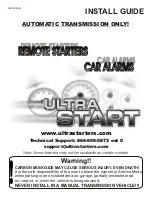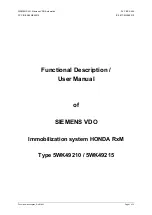
VESDA by Xtralis
VESDA VFT-15 Product Guide
www.xtralis.com
53
Data communication between detectors is done via an RS485 connection. The communication between
devices connected to the network is unidirectional. The polarity must be maintained throughout the network. It
is recommended that RS485 (Belden 9841 - 120 ohm) twisted pair cables (or similar) be used. You must
ensure that the network is appropriately wired. Refer to Section D.4 for further information.
You should now power up the system. Refer to Chapter 4 for details on the startup sequence for the detector.
If the detector does not start up as described, check that the detector and RS485 network have been correctly
installed.
Preliminary Systems Check
Conduct a preliminary systems check before you begin commissioning. The check can be conducted by
using Xtralis VSC or VSM4 PC based software.
At power up or when changing site requirements a range of faults will be generated, which is normal behavior.
To silence the faults you can accept the factory defaults, but you MUST remember that you still need to
configure the detector to suit the customer site.
Change the settings to suit site requirements:
l
Normalizing the air flow - Normalize the air flow using Xtralis VSC or the display panel. Refer to
Section 4.1 for further information.
l
Create smoke at the farthest sampling hole from the Detector to confirm that the detector registers the
presence of smoke at approximately 30 seconds for the default 15 x 50m tube configuration, and less
time where less tubes are fitted or where alternate tube configurations are used (refer to Section 3.3),
but also within the maximum time according to local codes and standards. This test should be
conducted for each pipe to ensure that there is no blockage or leakage in any of the microbore tubes.
For information on smoke tests refer to the VESDA Commissioning Guide.
C.2
System Configuration
Once all pre-commissioning activities have occurred, the detectors should be configured appropriately for the
site. It is recommended that all detectors should be configured with PC software, however if this is not
immediately available, then the detectors can be configured through the display panel. For more information
on configuring the detector, refer to Chapter 5.
C.3
System Integrity Testing
VFT detectors can be tested in a number of ways including performance-based smoke tests and test
functions available from the detector. Before commencing tests, ensure that the tests comply to local codes
and standards. Performance testing is done during commissioning and may be required during service, but is
not essential. We highly recommend pipe integrity testing be performed each year.
For more information about:
l
Performance-based smoke tests - refer to the VESDA Commissioning Guide.
l
Test functions - refer to Section 5.3.12.
Test results should be recorded in a copy of the VESDA commissioning form (Xtralis Document 12687).
C.4
Hand Over
Hand over of the system occurs once you and the customer are satisfied that all aspects of commissioning
the system have been addressed and meet the required standards. The system must be ready for day to day
operation prior to hand over. To hand over the system to the client, you should:












































